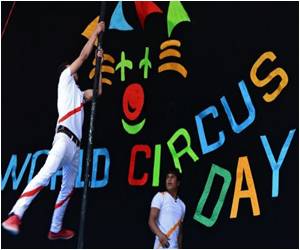A young man climbs atop a human pyramid and performs a perfect handstand. Nearby a girl effortlessly swings a dozen glittered hoops around her hips.

But unlike others, most of these artists, until recently, were not given a choice.
Eleven of the thirteen-strong troupe are rescued victims of child trafficking who had been sold into circuses in neighboring India and made to perform to crowds.
Now they are free to perform because they can, not because they have to.
"I like the fact I'm not being forced into doing anything now," says Anjali Chhetri Khadka, 20, who joined the troupe when it formed in 2011.
"I'm performing from my own free will and I can do whatever part of the performance I choose."
Advertisement
Families, impoverished and desperate, receive as little as 1,000 Nepalese rupees ($10) for the sale of their child, experts say. They are often tricked into believing a better life awaits their child across the border. But the reality is usually quite different.
Advertisement
"There are children there (in some circuses) as young as five or six years old," explains Leslie Brown, the Nepal representative for Freedom Matters, a UK-funded non-governmental organisation that works to rehabilitate rescued circus performers.
"They are taught to interact with and perform with wild animals, and they are very commonly abused, neglected and sexually molested,"Z she says.
Young Nepalis have traditionally been favoured by circus owners due to their small builds and fair complexions, according to Brown.
Once far away from their country and families, and unfamiliar with the local language and culture, trafficked children are easier to exploit and control, and less likely to run away, she says.
A typical day at a circus starts at dawn with several hours of gruelling training followed by at least three shows to the public that last late into the night.
"Some young girls are forced to carry out private performances to groups of men," according to Shailaja CM, who works for non-profit group Sano Paila and has carried out dozens of raids on Indian circuses since 2004.
Working alongside Indian authorities, they have rescued almost 400 trafficked Nepalis, including most of those now at Circus Kathmandu.
When they find them, 80 percent have tuberculosis, some are pregnant and most are suffering from injuries after years of physical abuse by trainers, she says.
"At the worst circuses, the children are normally happy to see the rescuers, but at others, they are frightened because the circus owners have told them that we will sell them into brothels and not take them home."
Years of successful raids and the criminal conviction of circus owners, encouraged the Indian and Nepali governments to continue to crack down on the exploitation of these children.
In 2011, India's Supreme Court also ordered circuses to stop employing children and instructed the government to rescue and rehabilitate working minors.
The following year Nepal endorsed the National Plan of Actions Against Trafficking of Persons which focused on preventing trafficking of women and children and prosecuting those responsible.
As a result, numbers of both child performers and children being trafficked for that purpose have "dramatically dropped", according to Shailaja.
But the rehabilitation of those already rescued continues. Most children return home to the lives they lost, but for some, reintegrating back into their families is impossible.
"It depends on many factors, for example stigma within the community, the belief that the child has brought back HIV/AIDS with them, that they are somehow spoiled," says Brown from Freedom Matters.
The organisation works to provide medical care and shelter to those in need and then helps get them back on their feet by teaching them new skills so they can earn a living.
Sunita Karki was trafficked into a circus when she was nine and rescued three years later. Now 20, she is studying for a law degree in Kathmandu and wants to help those who have suffered a similar fate.
"I'm going to work with organisations that rescue people from circuses," she says. "I want to become a professional lawyer and be good at what I do so I can help those in similar situations."Z
But for members of Circus Kathmandu, performing is a way of life and has become a career. Theirs is the only contemporary circus in Nepal, and they have set their sights on performing overseas, with a debut planned in Britain next year.
Source-AFP









